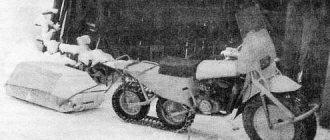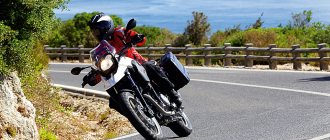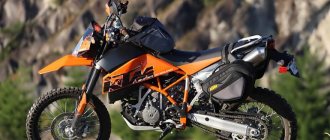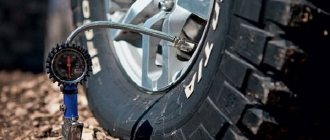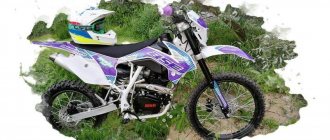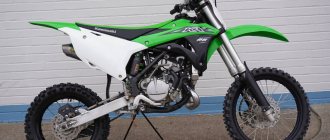How to properly set up a motorcycle suspension?
Among all the maintenance work on two-wheeled vehicles, adjusting the motorcycle suspension occupies a special place. It allows you to ensure maximum safety for the rider and improve the capabilities of the equipment, since the stability of the motorcycle depends on the correct settings of the chassis. In theory, adjusting the suspension should take a minimum of time and effort, since it only allows you to change six basic parameters. However, practice shows that such work requires long hours and even days spent studying instructions, expert recommendations and test runs. We will tell you how to properly adjust the suspension of a two-wheeled vehicle so as not to encounter problems in any driving mode.
Why do you need to adjust the suspension of a motocross or enduro motorcycle?
Beginners often have a question about why they need to adjust the suspension of a motocross or enduro motorcycle and why they can’t get by with the factory settings? After all, the plant employs highly qualified specialists with extensive experience who know better than others the features of the equipment produced by the plant.
The need for additional adjustment of the suspension of a motocross or enduro motorcycle is due to the fact that the factory settings are universal in nature and do not take into account the individual characteristics of a particular motorcyclist. For example, factory settings are made based on the rider’s weight being 70 kg. In addition, the factory settings cannot take into account either the specifics of the real track or the driving style of a particular driver.
In fact, the factory settings assume average driving conditions and the average driver. The result is suspension settings that are suitable for driving in any conditions, but are not optimal for a particular case.
Therefore, in order to optimally adapt the operation of a motorcycle to a specific motorcyclist and driving conditions, it is advisable to adjust the suspension of a cross-country or enduro motorcycle. Suspension adjustments can be made before each ride if the expected driving conditions differ significantly from previous ones.
Despite the significant differences between cross-country and enduro motorcycles, suspension tuning for them is carried out using the same methodology. The suspension should be adjusted using new or slightly worn tires, since heavily and unevenly worn tires radically change the behavior of the motorcycle on the road.
Setting sag is the only thing that everyone can do, but does it wrong. Here are some tips:
- First, always measure sag the same way.
- Second, bounce the harness before measuring sag.
- Third, sit where you are actually driving.
001_MOTO_0910_060
Fortunately, Evgeniy Borisovich Parshin kindly agreed to share his many years of experience in preparing champion motorcycles. And he invited me to his workshop - a racing mechanic's paradise.
The principles of tuning the suspension of road and motocross motorcycles are similar, the goal is also the same - to ensure good and maximum long contact of the wheel with the road. But offroad means relatively flat areas and steep hills, loose and hard, wet and dry. Yes, and you can drive through the same section in different ways - by rolling in, skidding, or leaning against the “side.” And all this in different combinations and at different speeds! It is therefore not surprising that a delicate compromise has to be sought. It's amazing that it can be found at all.
But first, just like on a road motorcycle, you need to set the suspension height. The principle of operation is the same. We outline control points for measuring the suspension travel (for example, the lower points are the wheel axles, the upper one in front is the lower yoke, the upper one in the back is the edge of the rear wing) and measure the distances between them in a free state (motorcycle on a stand), under the weight of the motorcycle itself (on wheels ) and with a rider in gear. Attention: from the front we measure along the fork legs, from the back - perpendicular to the ground (see figure)!
The design of modern motorcycles
The development of cross-country motorcycles has always followed the path of lightening and simplifying the design - the simpler it is, the more reliable the machine will be in operation and the easier it will be to repair. Modern production models, with some exceptions, can be considered the crown of such evolution.
The main components of a modern motocross motorcycle
- frame made of steel, aluminum or other light alloys,
- single-cylinder 2 or 4-stroke engine with air or water cooling (depending on class),
- rear progressive suspension with monoshock absorber,
- pneumatic or hydropneumatic “inverted” front fork,
- lightweight disc brakes,
- raised exhaust pipe with muffler,
- high-mounted wings with a large reach,
- minimum of plastic “body kit”.
A headlight, a dashboard, an electric starter, a battery, turn signals, mirrors, a footrest - all these elements required for comfortable and safe driving around the city are absent in the design of a real motocross motorcycle, since during the race they are simply not needed and promise only an increase in the total weight and more. frequent repairs.
One more fact is very interesting: there are also strict requirements for the design, obliging absolutely all manufacturers to actually work “according to a template”, releasing models that are like two peas in a pod similar to each other. Any deviation from the carefully verified formula threatens defeat. This could be either an obvious loss to competitors in one of the characteristics (and therefore a loss for the athlete), or a ban on admission to competitions due to the car’s non-compliance with the regulations and a complete lack of demand - no one will buy a cross-country model for urban use, since the trip to it is prohibited on public roads.
Compression adjustment is very difficult to do in a garage without test riding the bike, so I like to start by deliberately softening the compression.
Once you feel satisfied with the results of the static tests, you can move on to the next step: you need to set the damping range.
How. The next step is to set the compression and rebound range. And at the same time we will have to force ourselves to act in the opposite direction. That is, set for yourself two extreme adjustment points at which you feel that the setting is incorrect: the softest and the hardest. Now that you have two extreme points that you can feel, you can skip the suspension tuners and gradually narrow your damping range. 80% correct damping is an excellent result.
004_MOTO_0910_060
Rebound and compression adjustments are often linked. For some shock absorbers, they are generally connected to one - common - screw. It is better to start with rebound and only then move on to compression. Compression adjustment allows you to find a balance between ride comfort and wheel grip. The faster you go, the more load the suspension takes and the stronger the compression resistance should be. In general, for high-speed aggressive riding you usually need to loosen the rebound a little, add resistance to the fork compression and tighten both rear shock absorber adjustments. If there is separate adjustment of “fast” and “slow” compression, this is the guideline for them. When moving the suspension less than 1/3 of its travel, we work with “slow” compression, and more than 1/3 with “fast” compression.
Sometimes you can get lost in the process of setting up your suspension. In a figurative sense. It happens that after long experiments it seems that the ideal is somewhere close. But a couple more clicks - and instead of the expected success, you get a motorcycle with a disgusting suspension. In this case, you need to take a break, return all settings to factory settings and start over.
| WHEN TO REPAIR A SHOCK ABSORBER? Naturally, adjusting a faulty shock absorber is like stitching up a torn tire. The first signs that the unit needs repair or, at a minimum, disassembly are oil leaks on the rod, cavities and rubs on its surface, knocks or too easy movement. If, when lifting the motorcycle by the tail at the end of the rod stroke, the rebound force of the shock absorber suddenly disappears, it means that gas has escaped from the compensation tank (as a rule, it is under a pressure of 10 atm). Or maybe half the oil leaked out. If there is oil on the rod (pipe), it means there is dust and water inside the shock absorber. Manufacturers often declare the shock absorbers of modern motorcycles to be non-separable and do not sell spare parts for them. However, in practice they have to be disassembled, at least to change the oil. Unfortunately, the price of a unit reaches 30–50 thousand rubles, so many people choose repair between replacement and repair. When disassembling a fork or monoshock, all adjusting screws must be unscrewed. Don't forget to write down your previous settings! |
What to do if there is no rebound or compression adjustment? First of all, read the instructions and make sure that they really are not there. Often we have no idea about the hidden abilities of our motorcycles! If there really are no adjustments, you will have to adjust the hydraulics by selecting oil with a different viscosity. (Or by selecting a washer in the “pyramid” on the rod, but this is higher mathematics, in which many “pros” swim, so we’ll talk about it another time.) There are oils on sale with a viscosity from 2.5 to 20, but more often in total, 5, 7.5 and 10 are used. As a rule, it is not worth changing the viscosity by more than 2.5 units. The desired viscosity can be obtained by mixing oil of a different viscosity in the appropriate proportion. For example, draining half a liter of “five” and “ten” each, we get a liter of “seven and a half”. Just do not mix oils from different manufacturers, otherwise the result is not guaranteed! If you don’t know what oil viscosity is needed, the guidelines are as follows: for the front fork - 7.5, for the monoshock absorber - 5. If the hydraulics are of poor quality, then its characteristics will noticeably change after “breaking in”: due to increased clearances, it will become softer. Therefore, for example, shock absorbers of used (especially domestic) motorcycles, as a rule, require more viscous oil. For the winter, you can fill in oil with a slightly lower viscosity. However, keep in mind that when the shock absorber operates, it heats up. Therefore, if the suspension performance suits you, just change the oil before the onset of cold weather. The fact is that if there is water in the old oil (sucked from puddles or just condensation), the emulsion may freeze.
Yamaha PW50
The Yamaha PW50 model is a mini-bike designed specifically for teenagers, but its characteristics are not inferior to “adult” cross-country and enduro models. The 50 cc two-stroke air-cooled engine with a Mikuni VM12/1 carburetor develops a power of 2.7 hp. and a torque of 3.8 Nm. An automatic transmission with a centrifugal automatic clutch makes it easy to control the motorcycle, which has a gross weight of 39 kg. To prevent accidents, there is a gas limiter on the handle, and the spinal frame is welded from powerful steel pipes.
The motorcycle's suspension - a telescopic fork with 60 mm travel at the front and a swingarm with 50 mm travel at the rear - allows it to conquer even minor off-road conditions. Considering that the bike will be driven by a teenager and the fact that there is a speed limiter, drum brakes are installed instead of disc brakes.
Infectious two wheels 3. From classic to enduro at the price of a frame.
I am writing on the occasion of the completion of new modernizations.
As they say to me, passing by the process of innovation: “A bad head does not give rest to the hands” or “The dog has nothing to do - he... licks” - as if hinting. But these are people who are not knowledgeable and do not strive for growth. More and more local creative people are lured by photographs of half-naked ladies in front of their chariots, sometimes unremarkable ones. But your faithful servant will again try to surprise you with rusty, overcooked iron and garage engineering.
First, I’ll try to explain what kind of enduro it is and what “Yzh Plonita 5” has to do with it.
Planet 5
-
classic bike
. It's like a regular B/C class sedan. Like Lada in the world of motorcycles. Classics (not just Izhi, but as a class as a whole) are distinguished by an upright landing, more or less high ground clearance, a suspension that compromises in handling/stiffness/energy consumption and a low- or mid-range engine. As you probably already guessed, this is something in between everything, for comfortable movement on many types of surfaces.
Enduro motorcycles are relatives of motocross motorcycles. Close in appearance and distant in filling.
Enduro
- These are two-wheeled SUVs. They are divided into several more categories (soft, hard, tour), but the common features are: a motor with a wide torque range, energy-intensive suspensions (softer, with longer strokes), high ground clearance, exhaust from above and, of course, tires. These comrades talk about enduro in more detail and interestingly:
Why not just take a foreign car then? Why not a finished, tested and evenly welded product? Because 250 - 300 cc pepelats equivalent in power, even at a fairly advanced age, bite well. At a price. This is a sure 100k and above. On the one hand, it’s inexpensive, but on the other... Let’s just say it’s not for everyone, especially when the financial flow flows very well into four-wheeled projects. But I’d like to have enough for two, for a change!
“Sovietcycles”, “our vulgar self-pumpers” and whatever they call them come to the rescue... After all, for modest money they can give a lot of pleasure to a novice rider, and with some modifications - even more.
The best donors for this cause are the Planets. Especially 5 and PS. So to speak, top versions of single-cylinder Izhas. Quite unpretentious, high-torque and, I would even say, reliable. The engine cranks up to 5-6 thousand for the P5 and even up to 7 for the PS, with modifications to the ignition. If you have a Ural/Dnieper, don’t damage your motorcycle! It is long-wheelbase, too heavy, prone to overheating with a highly inert cardan drive. In general, there will be less pleasure in the end. Minsk, sunrise, owl - light, compact and also suitable. But less powerful and with their own problems (many people know for sunrise boxes, etc.) Jupiter is more capricious and less reliable. IMHO - Izh Planet is the best choice.
Improvements to two-stroke engines were discussed in the previous issue. Now about geometry.
To get a more or less suitable enduro from a classic Izha, you need to change the following parameters: 1. Increasing ground clearance
.
Everything is clear with this: higher is better. Usually by moving the upper fasteners to the rear and welding on the attachments to the front. 2. Reducing the base
.
This is the distance between the wheel axles. In stock - 145
cm, in enduro - about
132-137
cm. It also affects the geometric cross-country ability.
The smaller, the less chance of “sitting on your belly”, and the bike is more nimble and agile. 3. Increasing the length of the pendulum
.
The horizontal displacement of the wheel is reduced (dynamic change in the base), and the level of chain weakening during suspension moves is reduced. Stock - 400mm
, preferably
about 500
.
4. Reducing the fork angle
. The highly angled chopper is beautiful and stable, but clumsy. Sports with small angles are more controllable but have less stability. Therefore, it is desirable to reduce the angle from the average value of the classics, improving maneuverability and reducing the lateral loads on the feathers when jumping. The bonus is reducing the base =)
Adjust the clutch and brake levers
Both of these levers should be adjusted for ease of use. The initial setup of a motorcycle is not always suitable for the motorcyclist. To adjust the lever, you first need to sit on the bike, extend your arms, and feel your wrist arch as you extend your fingers to pull the lever. It is best that your wrist is not at an angle. Place a special measure from the steering wheel to the lever and check the angle. Compare this to the angle of the hand when the fingers are extended over the lever. Then make the following settings:
Pit bike or enduro: what to choose?
Before making your final decision, pay attention to the following subjective points that are relevant to you.
Driving conditions
In off-road conditions, a motocross motorcycle rides more confidently. However, a pit bike performs better on hard mud - there is less chance of getting stuck in it. Therefore, if you plan to ride through forests and fields, gravel, slopes, and overcome water obstacles, it is better to choose enduro.
Nature of travel
If you plan to make long trips on difficult roads, you should take a closer look at a pit bike. “Krosach” is still more suitable for not very long-distance high-speed rides, sports and stunt rides.
Speed
If this is a fundamental parameter for you, please note that pit bikes are somewhat inferior to motocross motorcycles in this regard. The latter accelerate to 160 km/h, while the former accelerate to 100 km/h.
Driving skills
If you are just starting to get acquainted with two-wheeled motorcycles, it will be more confident and safer to first “tame” a pit bike. He is a good teacher and coach! To ride a dirt bike, you still need to have some experience and skills.
Who's driving?
Pit bikes can withstand loads of up to 130 kg. But motocross motorcycles prefer lighter loads. Even if otherwise is not stated in the product passport, keep in mind that if the driver weighs more than 80 kg, the driving characteristics of the enduro will deteriorate.

